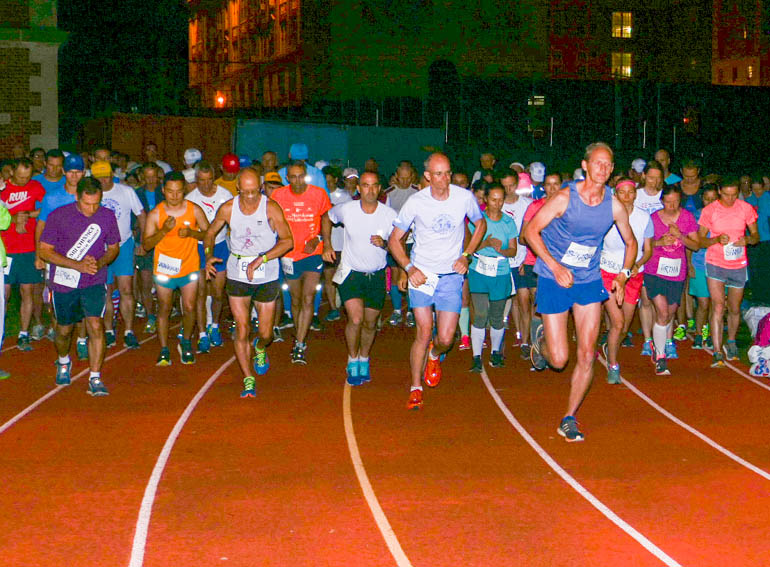‘Putting the distance into your own words’
The 47 mile race 2022
Since Sri Chinmoy’s 47th birthday on the 27th of August 19781, an annual 47 mile celebratory run has taken place in Queens. Students of his who feel inspired start the race at midnight and have 10 hours to complete the distance.2 For most the distance is absurdly long and yet many mere mortals do manage to complete it. Most of his students have tried their hand at it at least once whilst others do it year after year with unstinting dedication. Sri Chinmoy inspired his students by running it himself in 1979 and again in 1980 in a time of 11.27.23. He said, “The number 47 is very important to me because in 1947 India got its independence. With this run we are celebrating our inner freedom.”
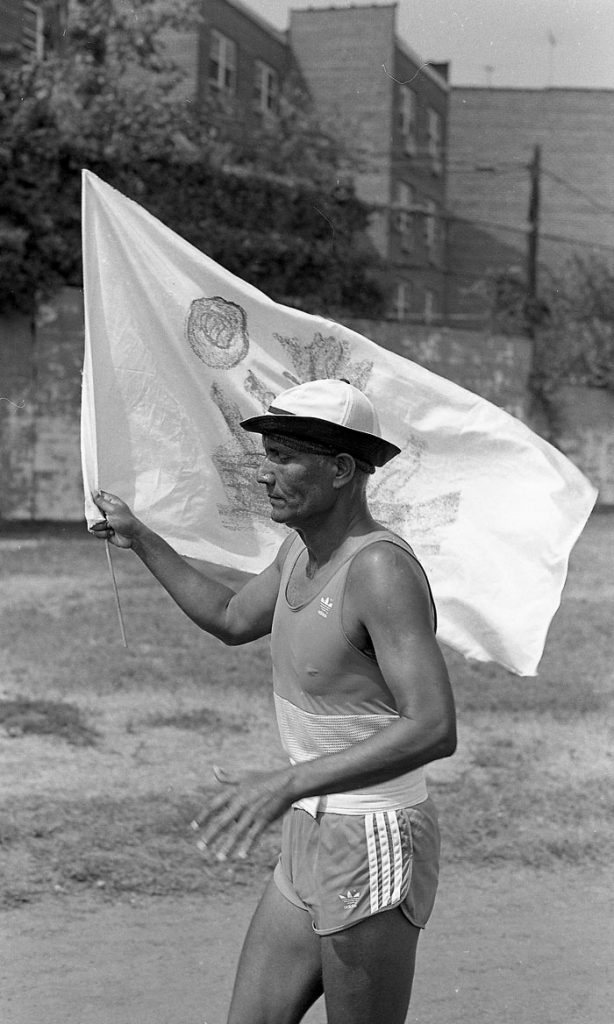
As midnight approaches a tangible peace descends in the neighbourhood; the trees and streets, indeed the air itself, exudes a sacred calm. It’s like a nectar that you can’t wait to lap up, perhaps similar to the feeling a child might have waking up on Christmas morning. The normal urge to sleep and blank out the world is suspended. When I first visited New York in the early nineties I used to help on the race, counting runners’ laps and organising refreshments. Despite the intense physical battle the runners were evidently experiencing I couldn’t wait to try it myself. The excitement of it all must cancel and override the mind’s natural fear of the distance. Close to the event, a friend might treat it like any other race and casually ask, “so are you running the 47 tonight?”.
For a race the route is so quirky that even an individual out for a short run on his or her own would probably not follow it. Yet for those that take part, every concrete paving stone, tree, dilapidated fence and incline is imbued with a sense of significance. Sri Chinmoy’s students have used the loop for hundreds of races from 2 miles upwards for decades. To say that this is a loop through a residential area is true but does not do any justice to the course or even give the faintest idea of it. Standing out and located more or less in the epicentre of the loop, on a slight hill, is Jamaica High School and its athletics track.3 The loop used for the 3100 mile race runs adjacent to it.
Flanking one corner of the loop is Goose Pond Park. For meditation students it’s also a place with a special feel as it’s used for music and play rehearsals, serving food and generally wandering around recovering from the intensity of all the activities and contemplating the meaning of it all.
Looking up you see the tops of tall trees swaying in the breeze and creating a canopy over the road there. The park itself is full of grassy patches, brown from the drought, interspersed with potholed pathways and a rather green murky looking pond, which surprisingly has turtles in it.
From the park there is an uphill section of about 300 metres, which though gentle is still very much uphill. Here the loop is run in the middle of the road and weaves between what might be called residential houses. It’s really the only bit like that which is why referring to it as a loop round the local neighbourhood doesn’t convey a very accurate impression. At the top of the incline the route turns 90 degrees to a welcome flat section, though it is into the path of possible oncoming traffic so one has to keep an eye out. This might be my favourite part of the course, perhaps because it’s also the highest part, but also due to the way the trees on both sides frame the road ahead and the sky opens up. It’s quieter up here and provides a brief respite, a chance to breathe in the surroundings and take stock of the situation. 4
Then the Margaret Tietz nursing home is on the right-hand side as runners descend a short but steep downhill section of around 125 metres. Nurses and carers come and go at all hours and large vans stop outside ferrying the disabled and elderly to and fro. A short hill like this is unusual on a one mile loop, especially when you have to do it countless times, but like the unimaginable distance, due to its absurdity it becomes a kind of mental relief. Until it just became too sore on the quads I liked letting gravity pull me down in a faster run here. During the night hours you really feel like you are flying at this part of the loop.
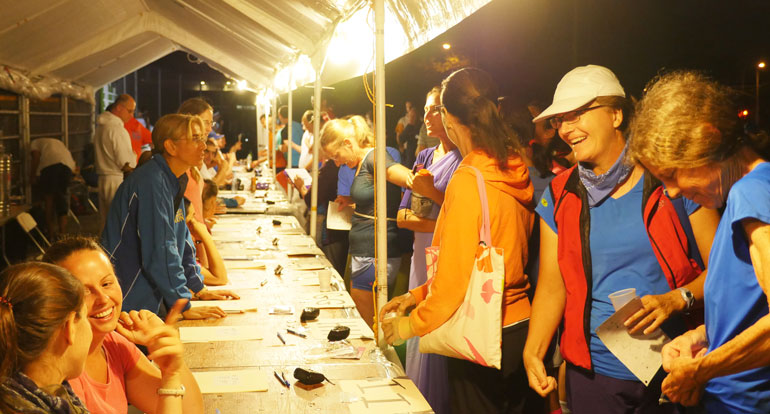
A tricky sharp 90 degree turn on the sidewalk at the bottom of the hill leads to another flat section but this is less inviting somehow. The road is generally busier and the concrete uneven creating a trip hazard. A wire fence runs along a grassy patch by the side of the nursing home and during the night you hear the sprinklers oscillating back and forth. Sometimes a cool mist of water comes out through the gaps in the fence and gently touches your legs. On the other side of the road there is a rather rundown Chinese takeaway, and a very dingy looking bar disgorging drunken individuals into the chaos of it all, before another sharp turn after a few 100 metres leads to a more interesting long straight of around 500 metres. It’s more direct to find a gap between parked cars and venture out into the middle of the road here rather than staying on the sidewalk with all its potholes. It’s quiet and there is only occasional one-way traffic coming towards you so it is not too problematic.
This part is flanked by the school running track on one side and an astroturf baseball field on the other. The loop is in a city and within the context of a residential loop but here more than anywhere as you run it feels as if you might be somewhere far more remote. The road is tree-lined and perhaps conjures up feelings of running along eternity’s road. The other side of the road incorporates part of the 3100 mile race course but that doesn’t seem to hold any meaning during this race, probably because it is totally separate and seems to be ‘sleeping’ waiting its turn to become the race that everyone is focused on (that is run by a very small elite group of runners so very different from this one that all sorts of people will be trying).
Under the trees during the early hours it’s quite dark as the street lights are either non existent or don’t work very well, but halfway along there are the bright lights of the tents and usually a huge cheer will break out as you run past the counters giving you energy for yet another loop.
Just after this section, on the corner, is an entrance gate through the tall wire fence onto the Jamaica High School track (usually part of the course though less so in recent years). Then another slight up and down section along the back of the school, with yet more memories and associations, leads back to the side of Goose Pond park. There is a mosque further down that road (beyond the running loop) and in the early hours men in their loose fitting white garments pass by on their way to morning prayers. After that is the real hustle and bustle of Hillside avenue with its heavy traffic, grime and what seems like continual screaming of sirens and the horns of firetrucks.
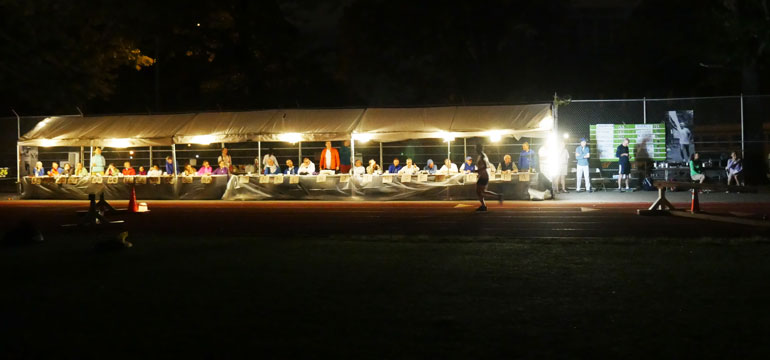
The loop can be run on the sidewalk but it’s more direct to come off and rejoin at different points, weaving between the parked cars and avoiding twisted ankles. During the night people come out and perform music to inspire the runners. This year there was a juggler, a group singing Indian songs with some jazzy accompanying guitar chords and a man reciting poetry from memory through the entire night (all students of Sri Chinmoy). Also, but more by chance than anything else and oblivious to the race, a rather blissful Indian man listening to Tagore songs on youtube in a fog of weedy smelling smoke (not a student of Sri Chinmoy!)
Despite the urban setting and the concrete there is abundant natural beauty around once you look for it or perhaps it’s not so much in the looking, rather just being faced with it so many times that you naturally start to see more. Curiously enough, in commenting on how to get through the race, one of the main things Sri Chinmoy highlighted was that nature’s beauty would help you. I found that curious as I don’t think anyone would look at the area and see ‘nature’s beauty’ yet during the race the surroundings do have an other-wordly feel and there is a special feeling of beauty surrounding you.
The organisers set up a group of small marquees on the sidewalk adjacent to the school track to serve as a base for tables and chairs for the counters, a medical area and a food area. There are two areas on the course for water where volunteers hand out drinks and call out ‘energy’, which is in fact NRG, a kind of electrolyte drink which has never been very appealing. Each time you pass the counters’ tent they call out your name and there is usually a tremendous cheer of encouragement right through the night. Runners, helpers, counters and passersby alike all partake in the special energy that descends every 27th of August.
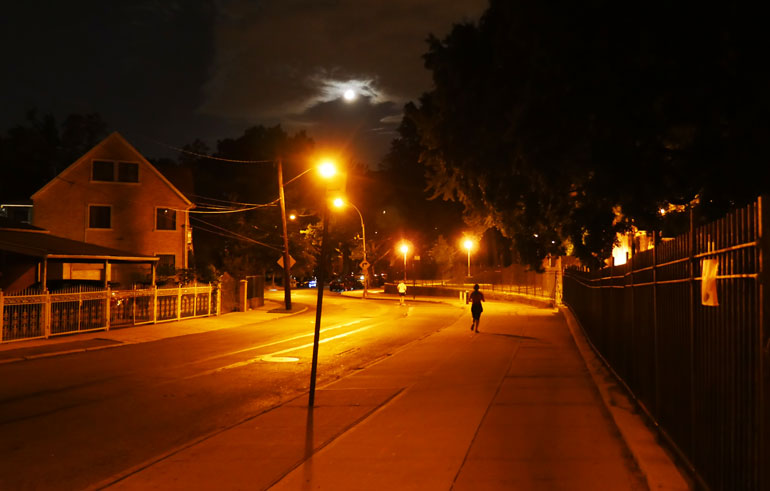
Normally the race is 40 laps plus once around the track on each lap. The track is the best part as candles in white paper bags are placed along its outer perimeter creating a magical atmosphere. It is only lit by the candles and a few old streetlights on surrounding streets.
The terracotta colouring of the surface and the light springy feeling underfoot makes a welcome change from the hard concrete. This 400 metre track section always feels effortless and is a respite before heading back out onto the battlefield again (another ‘favourite spot’ maybe). I used to enjoy watching the white lane lines shoot past under my feet, making me feel as if I was speeding along in a car looking down at the road. However, this year the track is under repair so the race has to be run entirely on the outer loop with all its hills, turns and weaving in and out of parked cars. That means merrily going round 56 times and 10 miles less of the ‘easier’ section. Also this year there were far fewer competitors than normal – perhaps around 45 compared to previous years when there have been hundreds. That means you are often running sections completely on your own and miss the buzz that having lots of runners creates.
One other factor is that the run follows on the heels of the Rockland Lake Marathon, which this year took place two days earlier on the 24th of August. The ’47′ begins as my birthday ends and it happens to be 56 laps, which is my age, all of which means I want to be on the start line. I’d trained well for the marathon and planned not to push it too hard. I was originally planning to aim for 3 hours 45 or less but closer to the time decided it would be better to be more conservative and just make sure I did it under four hours. Right from the start it was harder than expected, despite all the long runs in training, and it was a struggle to make 4 hours 10 minutes in the heat.
I felt good after the marathon but fairly drained by the time it came to the afternoon of the big race. Walking over to the start I felt exhausted and wondered if I would even be able to do a lap. I usually try to get an hour’s sleep beforehand, so got to the starting area a bit drowsy and rather bewildered by the bright lights and the frenetic activity. It feels a bit like a street market at night with runners, helpers and organisers going backwards and forwards, numbers being handed out and last minute offerings of good luck. Yet that tingling special feeling is always there. Normally for the start we would be inside the track with all the candlelight. This year was a bit different.
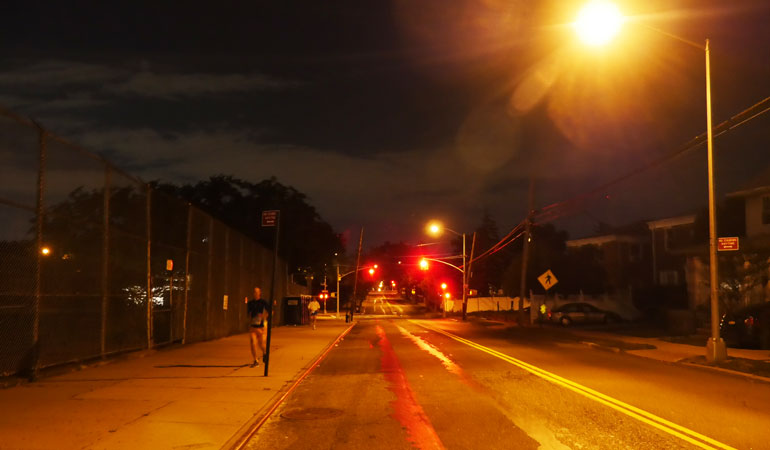
The first few laps I felt bloated and full of sugar (the low sugar diet had not been followed on my birthday!); not a pleasant feeling but I knew there was no way the discomfort could last much more than an hour or two. A solid thing that comes from having had some basic experience of these events, not much different to having training miles in the legs, is knowing that these physical discomforts will tend to lift quite quickly. Acutely sore blisters, aches and pains in the feet, stiff calves and mental tiredness will fade away. They feel like game changers but disappear very quickly if you can just ignore them for an hour or two.
In previous years, resting on my laurels of completing the marathon a few days earlier, I often tended to relax too much, enjoying the still air and the peaceful euphoric atmosphere. After walking quite a bit and building up reasonable mileage, with four hours or so remaining I would realise that it wasn’t going to be possible to complete, or else it would mean a feverish upping of the pace which was just so gruelling. I always regretted not being brave enough to take it seriously form the beginning and each time vowed to train and be more ready mentally for the following year.
I knew that you had to be determined from the very start; this wasn’t a holiday after the marathon, it was a serious business. So I started running and maintained a basic pace without stopping or walking at all. My watch ran out of charge early on so I had no idea of the pace but knew that it should be fine as long as I kept going. All was good but this is the stage when you realise you are just at the start of something immense. Using the analytical mind you’ve done say one to two hours, so you are not even a quarter of the way. It’s the point where I have to have some kind of survival plan or mental strategy to escape from the gloomy, calculating part of the mind.
I’ve come to the conclusion that for me it’s impossible to do the event thinking of it as it is ‘advertised’ or set out outwardly to the mind. You just cannot run the race on its outer terms. You have to find some way to tame and reinterpret it, stamping your individuality on it. In this case, for example, the idea of running 56 laps overnight, two days after a difficult marathon, seemed incomprehensible. Sometimes you need to be faced with that sheer impossibility to be forced to come up with a new strategy which in turn might touch upon a deeper undeveloped part of you.
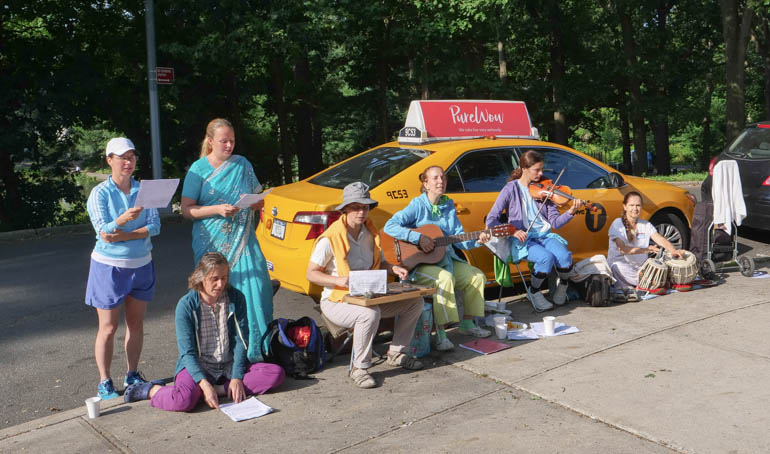
From previous races, since I had completed it a number of times I knew that it was possible, which is a good starting point for the mind. For longer training runs I have strategies already worked out (see here) and for longer events something usually suggests itself not too far into the race. However, I was an hour or so into the race and still no workarounds had presented themselves. Personally I just don’t seem to have the mental strength to look the distance in the eye and slowly start ticking off miles. I have the mental stamina to get about halfway and persuade myself that after that conditions will be different or the race will change somehow. Perhaps the sheer outer brutality of 56 laps does not lend itself to any kind of mental games.
If nothing is coming to you the main thing is at least just to continue. Try not to think ahead. Allow for wishful thinking that something will come in and save you. One just has to keep the mind as quiet and calm as possible and not think about the full extent of it all. Something always changes that allows you to see a glimmer of light, some ray of possibility, a mental image or a set of things that you need to do.
Indeed a soothing thought did come to me that solved it in an instant. It’s strange how this happens. It’s as if you suddenly put it all together inwardly and can see yourself getting through the bulk of the race with just a few loose ends to tie up at the end (see here). I had completed around 15 laps (just over 12 miles). As mentioned the previous races always included a 400 metre track element on each of the 40 laps. I hadn’t really thought about it in these terms before, but in total the race must obviously have included 40 laps of the track (10 miles) and those were always much ‘easier’ segments. I could certainly see myself completing 40 laps of the non-track element – that was the same as the old course. I wasn’t far off 20 laps and in fact enjoying the race; the light, the atmosphere, the fact that here I was in New York after all the travelling restrictions, no injuries, a reasonable marathon completed and lots of helpers and friends around.
If I could get myself to 40 laps then all that I would have left in my mind’s eye would be that easier track section. That could be done in my own time on the soft track with the candles and people around. If anything it would be a very enjoyable activity. Such is the way we are able gently to fool the mind – of course there was to be no soft candlelit track but it does seem to be possible to force the mind to reinterpret later distances and sections in more imaginative ways. This takes away quite a bit of the pressure and enables us to get on with some of the interim parts of the race in a less troubled way (most of the other posts on this site go into this in detail).
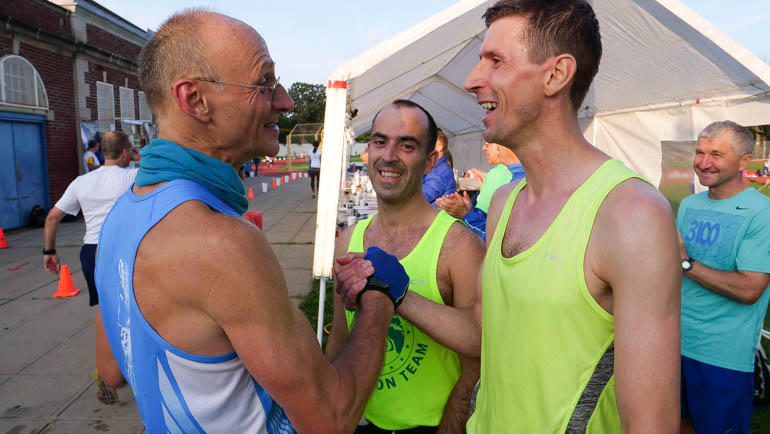
We seem to be able to defuse the difficulty of distances by brining them closer to home either physically or in our imagination. A marathon run around our back garden, even if thousands of laps, might seem less daunting than a long out and back course in a foreign city. Or perhaps a long swim in an outdoor pool close to home much easier than choppy and unknown Atlantic waters
I could certainly see myself getting through the 20s and up into the 30s making 40 laps a very manageable goal. At this stage it feels like it’s done. It’s as if you are allowing the mind free rein to think what it likes up to this goal of 40 laps but you are really using your will power to stop any thoughts of what will happen after that point. You come to an agreement with the mind that you will not discuss this matter until you actually get there. Each time the mind questions you, or starts to worry, you have to keep on and on reinforcing the imaginary image which in this case is the candlelit section (I think it helps in this case that this is in a sense real, as in previous years that section has been there – not quite in the form you have invented as one block of 10 miles, but as a 400 meter section every lap.
You know in the back of your mind that there will be a small second stage but you don’t have to worry about it until you get there. A certain amount of physical energy and a lot of determination is necessary to keep this fixed in your mind; perhaps 75% of your energy is being channeled into running and the remainder into keeping the mind from rebelling (or the mental part may well be more than that). I think that takes some practice and in fact should be part of every training session. I
t’s very akin to meditation. People sometimes feel that in learning to meditate they instantly have to put all thoughts out of their mind. This is incredibly difficult and it’s a shame that they then give up so quickly thinking it’s something they can’t do. It’s more about presenting yourself as an equal adversary to the negative thinking, rather like a tug-of-war. The thoughts are very much there but you fight and struggle to stop them gaining ground. With luck you might just overcome them enough to sneak in under the cut-off before they can get you. Regarding learning meditation, people sometimes say that it’s not for them as they are restless or can’t stop thoughts from assailing them. That’s very understandable but it’s maybe like seeing the enemy forces amassing in the distance and saying that you will not enter into the battle because you can see some enemy.
Of course this ‘track component’ is made-up and a complete fiction. At the 15 lap stage if you calculated your position in a cold-hearted way, then you would find you had about 34 miles left, which would be terrifying. You did a marathon a few days beforehand, it’s 2 am and the body is ready for a soft mattress perhaps with a fan gently lulling you to sleep and the prospect of waking up to a good breakfast. Yet somehow the little fiction you’ve created can keep that out of your mind.
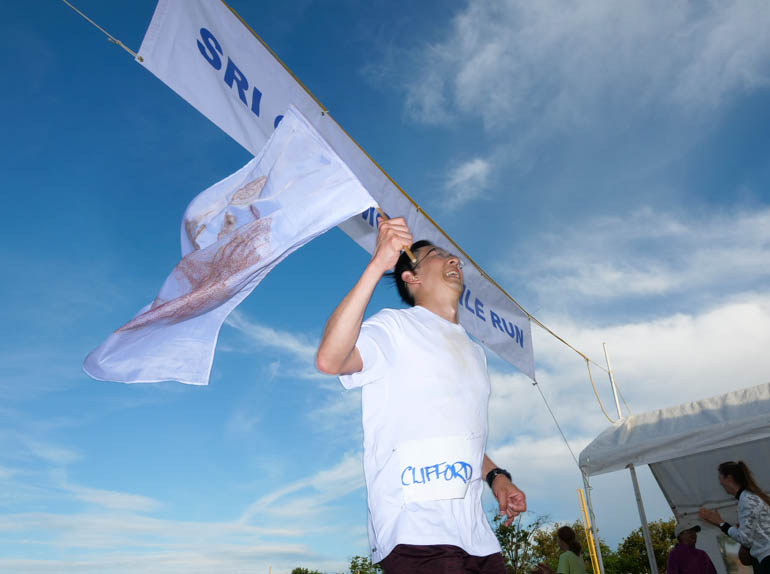
When I got to what I thought was 49 laps someone announced that I had 46. How could it be possible that I was now three laps off the original plan? On the next lap I told the counters that they must have made a mistake and still with that fiery inspiration to finish the race I kept on going at a reasonable pace, convinced they had miscalculated. I did what I thought was another four laps before confronting them. They told me that I now had 49 laps. Yet another lap seemed to have got lost, meaning I was now four laps behind. The race clock had stopped working, further strengthening my case against the race officials, and all I had to go on was a rather strange clock hanging on the front railings of one of the houses. It had flashing lights around it and for all I knew was not the correct time anyway. Also the race generally does not start at exactly midnight so race time is different from clock time. It was also easy to forget to look at that clock outside the garden gate and would mean waiting another lap each time to confirm. Time-wise things were not looking good and the ten hour cut-off was looming.
It can feel like a medieval torture when you are absolutely at the end of your energies and the more you push the further away you get. They assured me very diplomatically that no mistake had been made, but the grim news (grim to me but what they thought was good) was that if I continued at that pace I would finish in 10 hours and 17 minutes. Suddenly from proudly trotting around enjoying the race and thinking I had mastered it, I was fighting for my life (well to finish the race, though it seems more than that). The race was showing its true colours as it always had in previous years. How could I have been so presumptuous to think I knew better than the race deities.
My counting friends said they would wait for me, but that held no satisfaction for me. I wanted to complete the race officially and was also desperate to stop soon. A slow angry and frustrated lap followed. It was all their fault, they should have been more focused on me and explained the situation earlier. Of course they had done everything right and I was the one to tell them not to inform me of my laps each time I went past. On the next lap the assistant race director said it was no problem and that he had spoken to the organiser who said she was ‘totally cool’ with me finishing after the 10 hours.
At some stage there will still be another 16 difficult laps left and the harsh reality of it is that there will not be any softer track section, but it seems to act like a bridge. You are not completely in the realm of self-delusion, but at the same time your fiction has a kind of subtle reality or truth to it. Memory of previous successful finishes, the creative part of the brain and a kind of enthusiasm help switch off the dry, pessimistic, calculating part of the mind to allow you to get through at least to the 40 lap point. Even when the reality of it then kicks in, you will only have 10 miles left to complete the race, which somehow you will be able to tough out.
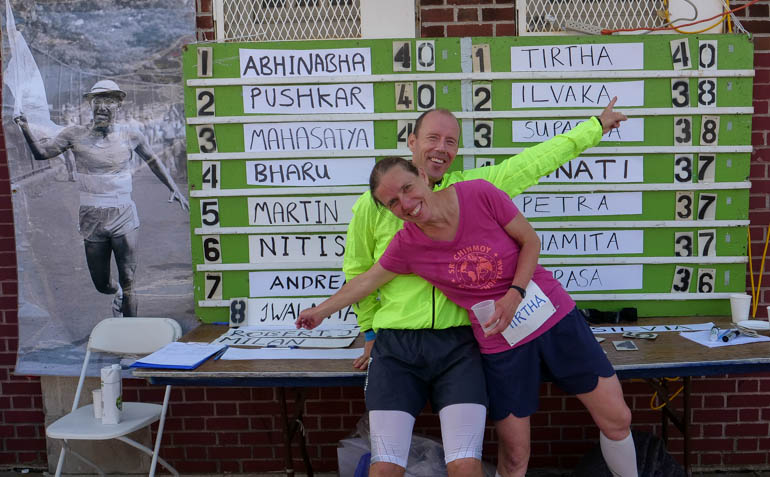
This quietening of the mind to get to that point keeps it happy, rather like you might keep a child happy on a long journey by coming up with games and ways to make it seem shorter. These games engage the mind and are not part of the dull, categorising part. Somehow the imagination is triggered and quite quickly, like a glimpse or intuition, you have an inner strength and certainty that you will finish. And these fictions do become powerful, much more than vague imaginary ideas. When recounting experiences of the race the next day I found myself talking about the easier track section as if it had really happened that way. Taking it any further I could see how suggestions might replace the actual reality of it.5
Once this strategy had settled into place I instructed my counter not to tell me the laps. I find that helps me keep a distance from the calculating and analysing part of the mind. Being informed outwardly that you have done a certain number of laps or that you are half-way can shatter this subtle alternative reality that you are painstakingly constructing.6
It’s also easier to underestimate a bit deliberately and get a few extra laps. With that technique I know that when I do check with the clock or the lap counters I’ll actually have more laps than I had admitted to myself. For example, once I’m sure I’m on 20, I’ll run four laps but then might not be sure if it was three or four, even though deep down I know it probably is four. I’ll assume it’s three and run two more to get 25 (so I know inside it’s actually 26). I might repeat that when I’m on lap 28 for example to get 31 laps instead of 30, which means I can really start focusing on getting to 35 without getting too caught up around 30. I know that 35 means I’ve got that short stretch to get to 40 at which point the soft candlelit track fantasy kicks in.
For some reason it’s an easier way to get a few extra laps; you are playing with the numbers rather than being ruthlessly controlled by them. At 30 laps (which in reality I know is more like 32), I might decide to be safe and do one more lap to make sure it really is 30 to avoid the horror of finding out I am only on 29. Another part of me is getting energy and excitement from thinking that I’m actually getting up close to 35 and that the 40 laps is basically in the bag.
Perhaps it opens the door fractionally to allowing in some kind of magic. On one level you yearn somehow to be five miles further on. If you mechanically look at a marker or see your mile total then that is immediately shut off and can be nothing more than a fantasy. If you can still be happy with your miles but fool your mind that you have a few less, then when you do ‘discover’ that you are further ahead it’s as if you’ve created that little bit of magic. I wonder if this is not a much deeper, more powerful and essential kind of imagination that is key for our mental health, similar to the importance of play, stories and fairy tales in children’s development.
There comes a point where you know you’ve got the 10 miles of track left or quite possibly less with the shenanigans described above. Of course it’s still the same loop and is in fact 16 laps. You can’t really imagine it as track now, but you’re not far off being home and dry. At this stage some kind of similar strategy is needed to get through these last laps. There is a fractal nature to all of this; an overriding strategy and then something similar being applied to each subsequent stage that you break it down into. Even the last lap can probably not really be completed on its own stark outer physical terms – I’ll get to a certain lampost and then say to msyelf that I won’t have to do that part again, then focus on getting to the halfway point in the lap and convince myself that the last half will really be nothing, and so on.
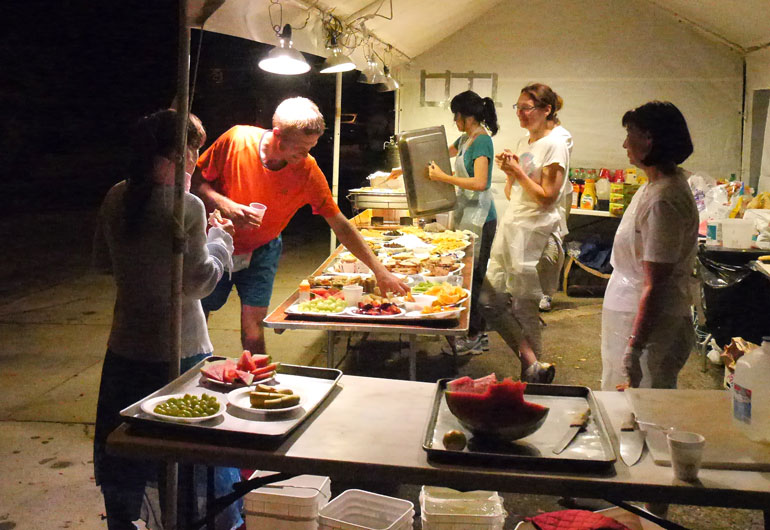
For the last 16 laps I focused all my attention on the first six, figuring that when I had 10 left then that would be manageable. Sixteen was still a little daunting and I felt I couldn’t look the distance in the face until I was down to 10 laps remaining. The sun was well up by this stage and it was already hot. Before completing the six laps to get to 10 remaining, I realised that eight laps remaining would equate to five miles, so in fact I started aiming for that interim point instead. A small thing but it keeps taking the pressure off the mind as otherwise when I got to 10 remaining that would seem daunting in its own way. 10 sounds a bit like 10 miles, whereas two more laps would mean I could focus my mind on five miles. Just before that, when it started really hurting, I could switch back a bit and think that at least I must be around the 10k or just over six miles remaining point. The fact that six miles does not fit in exactly with laps also helps you get through it as you never quite know where you are in the countdown. Again, 10k has a more friendly ring to it – you are converting harsh, fixed amounts into something more palatable, in a sense putting it into your own words. 10K is a known distance that I would have trained many times.
The power of imagination is very strong and can not only get you through it all but is the only way you can get through it. It’s essential you don’t give the mind too much freedom to indulge in mathematically calculating the distances – this would destroy the fragile fiction you are creating in a twinkling. In fact it’s a moot point if it really is a fiction at all, perhaps it is rather a more constructive and progressive angle on it.
In these ultra events I feel that the most one can envisage doing oneself is about half the distance or time. The other half has to come from somewhere else, outside the mind’s limited conservative focus. I had often managed to do 18 mile runs imagining I was only running eight (see here) and interestingly one suggestion Sri Chinmoy has for doing a marathon is to imagine you are only running 13 miles. That’s an extraordinary shift in the consciousness. It’s not just like focusing on 25 miles, for example, and allowing something to kick in at the end, rather it requires a complete mental shift. Figuring out exactly how one might go about doing that in practical terms becomes a very interesting question and, although it’s rather putting the cart before the horse, is possibly one of the main motivations for being involved in these events.
So far so good but this 47 mile race is unique and there’s always a sting in the tail. In previous years this was when, with four hours or so remaining, I’d ‘do the math’ and realise that it would be impossible to finish without increasing the pace way beyond what was bearable. Yet a fire and determination would be kindled and somehow, though I still can never really figure out how, I would manage to complete with seconds to spare. This time everything was comfortable and I felt as if I might even finish under nine hours. There certainly seemed to be no question of whether I would finish or not. I think there was some hubris in thinking I had fooled the gods with my simple little plan and I don’t think this is the kind of race that you can finish without losing a tiny bit of pride and having some humility drummed into you.
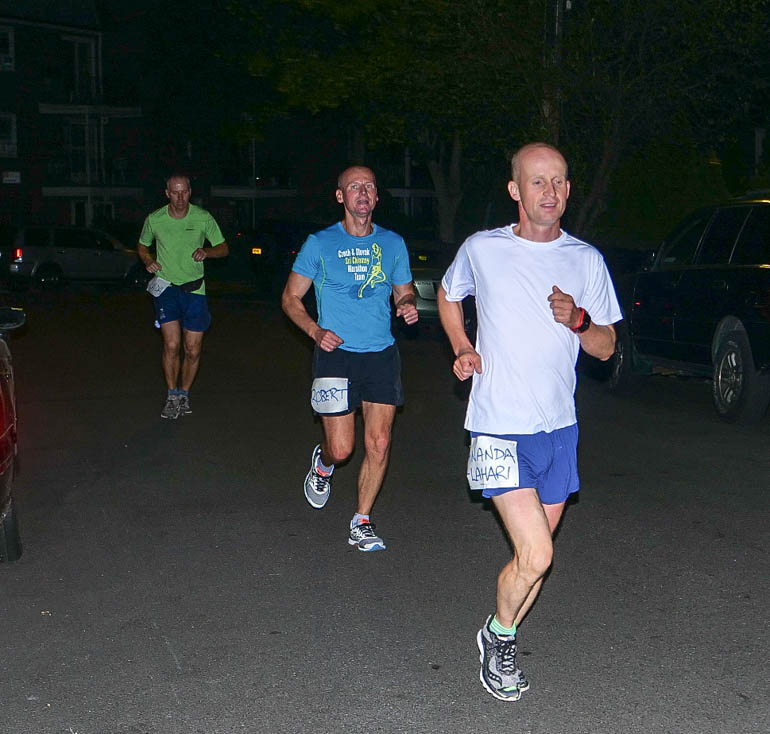
When I got to what I thought was the imaginary ten track miles remaining and in the mind the switch to the softer surface, I had about three hours left, which meant that I’d finish an hour inside the cut-off. Far better than anything I had achieved for over 20 years. This led to a slight relaxation and sense of satisfaction that starting this time with a bit more determination and being a bit better trained meant I had cracked it somehow. There was also the niggling feeling that perhaps something was wrong. At this 40 lap point a friend passed me and said that we had more or less the same pace and that I should be able to finish 7. He said he had passed me twice so must be two laps ahead. He was on lap 40 too, which meant I could only have been on lap 38. That was already quite a blow for the mind and his telling me that I ‘should’ finish was not what I wanted to hear.
I was under the illusion that there was no question I would finish. So I was two laps further away than I thought and also it was going to take an hour more than I had planned. I took it on the chin and decided to put it out of my mind, continuing with plan A, and leaving those two extra rogue laps to be dealt with somehow at the end. In the meantime I would continue knocking off the remaining 16 laps (to think of 18 was too much). I’ve written quite a bit about how one can ‘take’ laps out of the equation and in a sense do them later on (see here)
As mentioned above the cut-off time has varied over the years (originally being 13 hours). I’m not sure how you could quantify the difference between previous years and this year with no track and the construction work, but I like to think it added on a few miles. Helpers were very encouraging, telling me that I was doing well and would finish soon (a bit outside the normal cut-off time). In my annoyed state I almost didn’t want to hear this as I would still have to push it for another 45 minutes but I quickly decided just to go for it. There were ice packs available and running around with them in my cap and applied to my face, somehow I toughed it out and was able to finish in 10 hours and 12 minutes.
Finishers get a flag to run around with on the last lap. Depending on the standard of the other participants, you start to see flags from about six or seven hours onwards and dream of finally being the one to hold one. For me the peace and stillness of the night had given way to hot sun and pneumatic drills at full decibel on the part of the sidewalk being repaired. They were also working with a saw, cutting through the concrete, with no ear protection. The suffering I was enduring seemed to pale into insignificance compared to their daily grind. Life just seemed tough everywhere!
I think the ice packs saved me. I had one under my cap and was pressing one to each side of my face whilst trying to get the last few laps done. Some passersby must have thought this very extreme. Three laps to go. Ok just think of it as two laps and then the last one is with the flag and is different. In fact just think of it as this one which I’ve already started and then the second one can be like a last lap which doesn’t sound so difficult. But they are always difficult and getting the flag was not like the dream of holding it. I couldn’t relate to it but then I was going fast to the finish line and it was all over.
Within 15 minutes I’m back at my accommodation and showered as I have to head off straight away and walk a mile to join a singing group. We are performing any minute and it’s been four months working on this set of songs. My walking route takes me back to part of the loop for a moment but I’m under a bright blue sky and those tall trees in the park are swaying majestically in the breeze. Heaven has descended to earth.
In writing this in the weeks after the race, how I wish I could keep the same spirit in day-to-day life. It seems that one falls back so quickly into planning and worrying about the future.
Let us not worry
About the future.
Let us only do the right thing
Today,
At this moment,
Here and Now.
Let the future take care of
Itself.Sri Chinmoy
- Interestingly 57 out of 58 starters finished the race that time and that’s before ultras really took off in the world. Whilst the field has often been over 200, this year there are somewhere between 40 and 50 runners. ↩︎
- At the beginning the cut-off was actually 13 hours. I think one year it may even have been 9 hours. Luckily for me the last few years they have given me and one or two others another 10 or 15 minutes or so! ↩︎
- It was a cinder track up until the 2000s and after the race your legs and socks would be coated with thick dust and grime. Sri Chinmoy often used to train there and held other events there like poetry readings. ↩︎
- Discussing the 3100 mile loop and how to manage the distance Sri Chinmoy once said that runners should find a part of the course that was special to them. That could even be a certain tree, bit of fence or really anything that you connected with. I’ve found myself doing this in multi-day races and one does find special parts of the course that give you a little thrill each time you pass them. I think it encourages you to look out for these things more keenly as it’s as if there will be something out there for everyone. Perhaps it also makes you treat the surroundings in a less materialistic kind of way, not just as so much concrete to cover but rather a sacred kind of place. ↩︎
- Almost 6 years ago I joined a singing group dedicated to singing all of Sri Chinmoy’s songs. This requires memorising close to a 1,000 quite tricky songs each year (mainly in Bengali). In order to get the order I use the memory palace or donkey bridge technique, associating each song with a place. What is most interesting is how when you visit that place again in real life, the song seems to have become more real than the physical place itself. So many times have you thought of the place in your imagination that it takes on a whole new reality. In the imaginary world it is quite a vibrant place compared to the rather dull real world version. ↩︎
- Swimming across the channel one time and working hard to visualise that I was nearly there, or perhaps at least three-quarters of the way, the captain appeared and proudly announced that I was doing very well and that we were almost half-way. It was very deflating. to hear this when you think you have almost finished. Well you know you haven’t but you are keeping that only ‘halfway’ idea very much in the background. It was like being told in no uncertain terms that there was no Santa claus.. ↩︎
- This was in fact Andrea Marcato who is one of the top ultra distance runners in the world having won the 3100 mile race four times and many other races. At the time he was just warming up for the 3100 mile race starting a few days later! The only time I’ve been within a few laps of him is on the first laps of a race! One time after a 10 day race a few of us were relaxing in a cafe the next day and there was a chess board out. I showed him the rules quickly as he had never played before (I’m not very good but have played since I was a child) – he beat me on the first game! ↩︎
